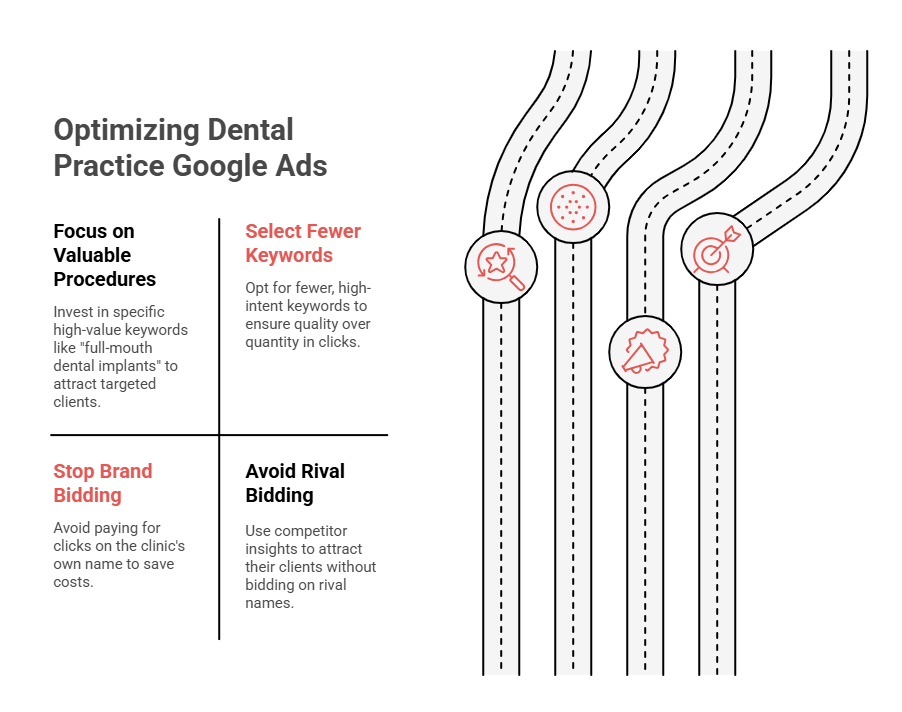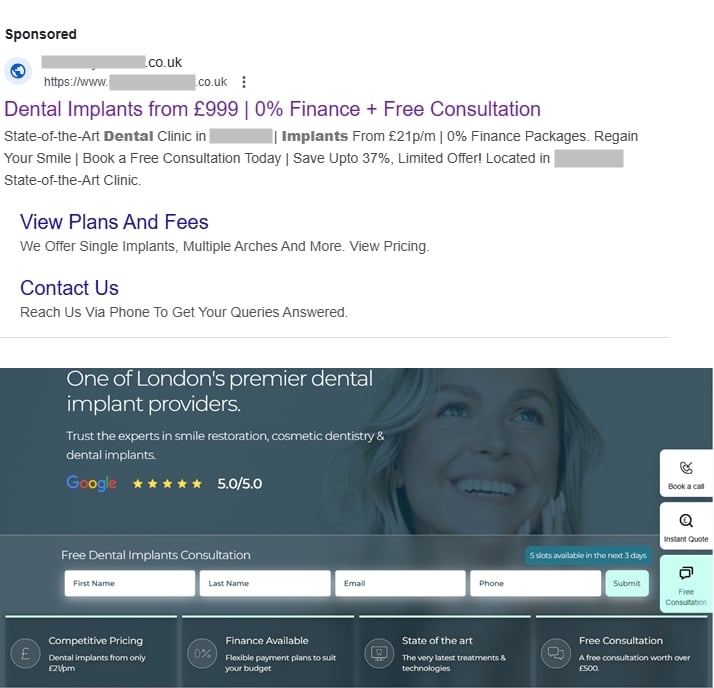Google Ads for Dental Implants

Last Updated on: 12th September 2025, 11:06 am
If you’re offering dental implants, Google Ads can easily be one of your strongest sources of qualified leads. The high-intent patients you want are Googling implant solutions, phone in hand, one ad away from an appointment.
But will they see your clinic’s ad? And if they see it…will it drive them to action?
If you’re using Google Ads, you should say “yes” to both. But daily, I hear dental practitioners say Google Ads “just doesn’t work.”Yet, every single time I audit their accounts (and I’ve done hundreds of audits), I need to say the following harsh words: “It’s not Google Ads. It’s you!”
Poorly structured campaigns, irrelevant keyword targeting, and budget-wasting clicks might be pulling in everyone except the actual implant patients ready to book consultations.
So today, let’s make sure your Google Ads for dental implants avoid the pitfalls I usually see and start with strong ROI!
What’s Really Sabotaging Your Dental Practice’s Google Ads Results?
1. Your Google Ads for Dental Implants Are Disorganised (and It’s Costing You)
I’ve audited accounts where hundreds of unrelated keywords were crammed into a single ad group like a junk drawer of dental terms.
You might ask: “What’s the worst that could happen with a few stray terms here and there?”. It’s the quickest way to burn through your entire budget without seeing a significant return on your investment.
In my recent audit for Google Ads for dentists, the account had 100+ unrelated dental implant keywords grouped together. Google had no clue whether the practice offered routine cleanings, crowns, or advanced procedures like full-mouth dental implants. Yes, it could offer all of the above, but potential patients are looking for only ONE THING at that exact moment.
No wonder conversions were down and spending was up! There was no relevancy between the keywords, ad copy and the landing pages on the dentistry’s website. It was causing the costs to rise without the right visitors seeing the ads that matched their searches.
Let’s organise that drawer, shall we? Because when your ad groups lack structure…
- Google struggles to match the right search queries to your ads, so, a lot of the time, you end up paying for your ad to not convert.
- You drown in irrelevant leads, wasting valuable staff time following up on inquiries that go nowhere.
- Your CPC rises, and your Quality Score plummets as Google simply can’t tell what your clinic truly specialises in.
Best Practices for Organising Your Google Ads for Dental Implants
- Organise your ad groups around tight themes. Have separate groups for “Full-Mouth Implants,” “All-on-4 Implants,” and “Implant Financing,” each with only closely related keywords. Other cosmetic dentistry services you want to advertise on Google Ads? They need to be in separate campaigns.
- Separate campaigns by goal or budget. If one type of service has a higher ROI (like high-value implant procedures), give it a separate campaign with a higher budget and priority.

As I explain in my personalised healthcare case studies (which include a dental client generating 35-40 leads every single day), organisation and a structured campaign plan is key.
2. You’re Targeting Everyone, Including Spam Clicks
Another not-so-jaw-dropping discovery from one of my audits was that the Display Network had accidentally been left turned on, meaning valuable dental implant ads were showing up for people reading unrelated forums and blogs.
Even worse, the account didn’t have a single negative keyword in place. They were paying for clicks from terms like “cheap dentist” and funding traffic that would never, ever convert.
Competitor names weren’t excluded either, meaning the clinic was paying good money to advertise their rivals’ businesses instead of their own.
Worst of all, Google’s algorithm was learning from this poor-quality data, which meant the situation kept deteriorating, month after month.
How to Fix Common Issues with Google Ads for Dental Implants
- Turn OFF the Display Network immediately. Just do it.
- Implement negative keywords immediately. Block terms like “cheap,” “free,” or irrelevant services (“teeth whitening,” “emergency dentist”) that drain your budget without bringing any qualified leads.
3. Your Budget Isn’t Aligned With Reality
Your budget might be holding you back more than you realise.
If your budget’s too tight, Google just doesn’t show your ads enough, which means fewer people click, fewer conversions happen, and Google learns nothing useful. Then, if you try and stretch that limited budget by going after cheaper, broader clicks, you’re trading potential dental implant patients for bargain clicks.
From my audits, here’s what I often see going wrong for dental practitioners:
- You might be paying Google for clicks from people already searching for your practice. Google will happily take the money for searches you would have captured anyway.
- Default settings shouldn’t be auto-applied. Google’s default is bidding on branded keywords automatically, which sounds helpful but actually makes you pay extra for something you should easily get without spending a penny.
How to Strengthen Your Practice’s Account
- Channel your budget towards your most valuable procedures. For dental implants, that means zeroing in on specific keywords like “full-mouth dental implants” Don’t put your money on terms like “dentist near me” – not for speciality services. Too generic, too costly.
- Choose fewer keywords, but choose wisely. You’ll pay more per click, but it’s worth it. Would you rather have 100 vague clicks from general searchers or 10 high-intent visitors typing in “dental implant prices in (your city)”?
- Stop paying for your own brand traffic. Double-check Google’s devious default settings and switch off bidding for your own clinic’s name, particularly if your website is already optimised for conversions.
- Don’t advertise on your rivals’ names (yet). Instead, use insights about your competitors to target people who have searched specifically for their implant services but haven’t yet converted. Then position your clinic as the better option.

4. Your Google Ads for Dental Implants and Landing Pages Aren’t Talking to Each Other
The client I recently audited had set their campaigns to “maximise conversions” without the right controls in place, which flooded the landing pages with poor-quality clicks.
The landing pages proudly reported 30 booked appointments, but zero actual conversions.
In PPC vocabulary, it’s a sure sign of spam leads skewing the numbers.
Even when Google’s AI isn’t to blame, I’ve seen leads click on a Google Ad promising full mouth implants, only to land on a general dental services page. It’s an instant disconnect, every single time. Your prospective patients didn’t click because they wanted to see photos of your clinic or how friendly your staff is.
They clicked for the implants promised to them in the ad.
Plus, long, generic landing pages listing every possible dental service make it hard for visitors to find what they’re after. If a visitor has to work to find relevant information, you’ve already missed your chance to convert them.

How to Optimise Your Landing Pages
- Create dedicated landing pages for every major service. If you’re running ads specifically for full-mouth dental implants, your landing page should only be about that. Clearly state your key selling points – no general dentistry distractions.
- Keep messaging consistent. If your ad promises a “Free Implant Consultation,” your landing page headline must clearly mirror that exact phrase or very closely match it.
- Highlight your primary offer prominently. Don’t bury important details lower down the page. The headline or immediate vicinity should clearly reaffirm the visitor’s expectations.
5. You’re Not Properly Tracking Conversions (Real and Offline)
I’ve audited countless dental practices, and it’s genuinely surprising how many still stop at tracking simple clicks or initial phone calls.
But clicks and calls aren’t always patients in your waiting room.
Think about what happens after someone fills out your contact form or picks up the phone: Did they actually show up? Did they move forward with treatment, or did they vanish after the first interaction? Assumptions are an expensive way to manage a campaign.
How to Properly Track Conversions for Your Dental Implant Google Ads
- Get detailed with Google Ads conversion tracking. Track form submissions, phone calls, and booked consultations separately. But don’t stop there. Not every submission or phone call leads to an actual patient. You need to separate real bookings from spam or accidental clicks (like a competitor checking your pricing or someone misdialling your number).
- Filter out fake “conversions.” Add a verification step in your CRM. Mark an appointment as a “conversion” only once it’s confirmed and the patient walks through the door. That’ll save you from celebrating ghost appointments.
- Include your offline conversions, too. When a potential patient calls your office, capture their Google Click ID (GCLID) right in your CRM. Upload this offline conversion data regularly into Google Ads. Now, Google learns exactly which ads, keywords, and campaigns are driving real, paying patients.
Here’s What Happens Next
Once you’ve cleaned up your structure, refined your keywords, blocked spam, perfected your ad copy, and tracked conversions properly…it’s OVER for your competitors.
Jokes aside, your ads will attract fewer – but far better – clicks.
Don’t be fooled by larger numbers. Sometimes, they don’t represent anything.
In fact, your immediate CPC might rise temporarily, but that’s good! You’re no longer paying for random clicks, people looking for free services, or competitors’ names. Instead, you’ll be paying for highly qualified, ready-to-book implant patients.
This isn’t just theory. Rather, it’s exactly how I’ve successfully managed dental implant campaigns for my clients for well over a decade.
If you’re serious about turning your dental implant Google Ads into a lead-generating machine, let’s chat. From my 17+ years of experience managing and fixing PPC campaigns, I’d love to help you get the results you’ve been missing out on.
Ready to do Google Ads the RIGHT way? Let’s talk!
